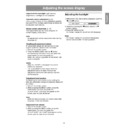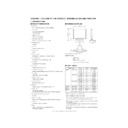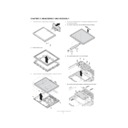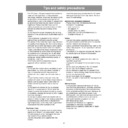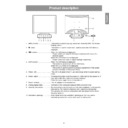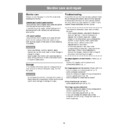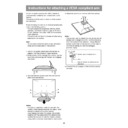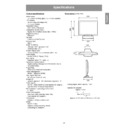Sharp LL-T15A3 (serv.man13) User Manual / Operation Manual ▷ View online
11
English
Deutsc
h
Fran
ç
ais
Italiano
Espa
ñ
ol
English
Adjusting the screen display
Adjustment the backlight (right column)
Brightness of backlight can be adjusted.
Brightness of backlight can be adjusted.
Automatic screen adjustment (p.12)
The CLOCK, PHASE, H-POS (horizontal position-
ing) and V-POS (vertical positioning) functions can
be adjusted automatically.
The CLOCK, PHASE, H-POS (horizontal position-
ing) and V-POS (vertical positioning) functions can
be adjusted automatically.
Manual screen adjustment (p. 13)
Fine adjustments can be made using the On
Screen Display (OSD) Menu.
Fine adjustments can be made using the On
Screen Display (OSD) Menu.
Note:
- All adjustments will be saved even after turning
- All adjustments will be saved even after turning
the power off.
Resetting all adjustment values
All adjustment values can be returned to their
original ex-factory values in one command.
1. Turn off the monitor power.
2. Press the MENU button and the
original ex-factory values in one command.
1. Turn off the monitor power.
2. Press the MENU button and the
button
simultaneously, and while doing this press the
power button (i.e. turn the power on).
When [ALL RESET] appears on the screen, the
reset is complete.
power button (i.e. turn the power on).
When [ALL RESET] appears on the screen, the
reset is complete.
Notes:
- While ALL RESET is displayed, the control
- While ALL RESET is displayed, the control
buttons are disabled.
- It is not possible to reset values when the
adjustment lock is in place. Remove the
adjustment lock before attempting to operate
control buttons.
adjustment lock before attempting to operate
control buttons.
Adjustment lock function
By disabling the control buttons (i.e. setting the
lock) any attempted changes to adjusted values will
be voided.
1. Turn off the monitor power.
2.While pressing the MENU button, press the
lock) any attempted changes to adjusted values will
be voided.
1. Turn off the monitor power.
2.While pressing the MENU button, press the
power button (i.e. turn the power on).
[ADJUSTMENT LOCKED] will appear on the
screen, and the lock will be set.
[ADJUSTMENT LOCKED] will appear on the
screen, and the lock will be set.
Note:
- When the lock is in place, all buttons other than
- When the lock is in place, all buttons other than
the power button are disabled.
Adjustment lock release
1. Turn off the monitor power.
2.While pressing the MENU button, press the
1. Turn off the monitor power.
2.While pressing the MENU button, press the
power button (i.e. turn the power on).
[ADJUSTMENT UNLOCKED] will appear on the
screen, and the lock will be removed.
[ADJUSTMENT UNLOCKED] will appear on the
screen, and the lock will be removed.
Adjusting the backlight
1. Without the OSD Menu being displayed, push the
or the button.
2. Adjust by pressing the button (darker) or
button (lighter).
3. Press the MENU button.
On Screen display for adjustment will disappear.
Note:
- On Screen display for adjustment disappears
- On Screen display for adjustment disappears
several seconds after the last operation.
12
Automatic screen adjustment
Options in the ADJUSTMENT Menu can be
adjusted automatically (CLOCK, PHASE, H-POS,
V-POS).
adjusted automatically (CLOCK, PHASE, H-POS,
V-POS).
Note:
- When setting up this monitor for the first time or
- When setting up this monitor for the first time or
after having changed an aspect of the current
system, perform an automatic screen adjustment
before use.
system, perform an automatic screen adjustment
before use.
Automatic adjustment screen display
To perform an automatic adjustment, first display
an image that makes the entire screen very bright.
If you are using Windows, you can also use the
Adjustment Pattern on the accompanying Utility
Disk for Windows.
an image that makes the entire screen very bright.
If you are using Windows, you can also use the
Adjustment Pattern on the accompanying Utility
Disk for Windows.
Displaying the Adjustment Pattern (for Windows)
This explanation is for Windows 95/98/2000/Me/XP,
and assumes that the floppy disk drive is [A drive].
Note:
- If the floppy disk drive of your computer is not
This explanation is for Windows 95/98/2000/Me/XP,
and assumes that the floppy disk drive is [A drive].
Note:
- If the floppy disk drive of your computer is not
"A drive", please read the below substituting the
floppy disk drive you are using in place of
"A drive" or "A".
floppy disk drive you are using in place of
"A drive" or "A".
1. Place the Utility Disk (provided) into the
computer's A drive.
2. Open [My Computer] and select [3 ½ Floppy
(A:)]. If using Windows 3.1, open [File Manager]
and choose "A drive".
and choose "A drive".
3. Double click on [Adj_uty.exe] to run the
Adjustment Program. The Adjustment Pattern will
appear.
appear.
Adjustment pattern
After completing the adjustment, press the
computer's [Esc] key to exit the Adjustment
Program.
computer's [Esc] key to exit the Adjustment
Program.
Note:
- If your computer's display mode is set to 65K
- If your computer's display mode is set to 65K
colors, you may see the different color levels in
each color pattern or the gray scale may look
colored. (This is due to the input signal
specification and is not a malfunction.)
each color pattern or the gray scale may look
colored. (This is due to the input signal
specification and is not a malfunction.)
Adjusting the screen display
Automatic adjustment
Automatic adjustment can be performed using
either the AUTO button or the MENU button.
either the AUTO button or the MENU button.
Automatic adjustment using the AUTO button
1.With the OSD Menu not displayed, press the
1.With the OSD Menu not displayed, press the
AUTO button.
2.Press the AUTO button again.
[ADJUSTING] will appear on the screen, and
after a few seconds [ADJUSTING] will disap-
pear. (The automatic adjustment is now com-
plete.)
after a few seconds [ADJUSTING] will disap-
pear. (The automatic adjustment is now com-
plete.)
Automatic adjustment using the MENU button
1. Press the MENU button.
1. Press the MENU button.
The ADJUSTMENT Menu will be displayed.
2. Press the button.
The screen will become dark and [ADJUSTING]
will be displayed. After a few seconds the
ADJUSTMENT Menu will return. (The automatic
adjustment is now complete.)
will be displayed. After a few seconds the
ADJUSTMENT Menu will return. (The automatic
adjustment is now complete.)
3. Press the MENU button 4 times to make the
OSD Menu disappear.
Notes:
- In most cases automatic adjustment is sufficient.
- If necessary due to any of the following, manual
- In most cases automatic adjustment is sufficient.
- If necessary due to any of the following, manual
adjustments (p. 13) can be performed after the
automatic adjustment.
- When further fine adjustment is needed.
- When [OUT OF ADJUST] is displayed. (When
automatic adjustment.
- When further fine adjustment is needed.
- When [OUT OF ADJUST] is displayed. (When
the screen displays an entirely dark image, the
automatic screen adjustment may be disabled.
When making an automatic adjustment, be
sure to either use the Adjustment Pattern or try
displaying an image that makes the entire
screen very bright.)
automatic screen adjustment may be disabled.
When making an automatic adjustment, be
sure to either use the Adjustment Pattern or try
displaying an image that makes the entire
screen very bright.)
13
English
Deutsc
h
Fran
ç
ais
Italiano
Espa
ñ
ol
English
ADJUSTMENT Menu
MANUAL: Individual menu options are manually
adjusted.
AUTO:
Every menu option is automatically
adjusted.
adjusted.
Notes:
- Press the button to select [AUTO].
- To choose a menu option:
- Press the button to select [AUTO].
- To choose a menu option:
button
- To go to the next menu: MENU button
CLOCK
The figure below demonstrates how to adjust so
The figure below demonstrates how to adjust so
that vertical flicker noise is not emitted. (
buttons)
buttons)
PHASE
The figure below demonstrates how to adjust so
that horizontal flicker noise is not emitted. (
buttons)
Note:
- Adjustments to PHASE should be made only
The figure below demonstrates how to adjust so
that horizontal flicker noise is not emitted. (
buttons)
Note:
- Adjustments to PHASE should be made only
after CLOCK has been correctly set.
H-POS (horizontal positioning) and V-POS
(vertical positioning)
To center the screen image within the boundaries
of the screen, adjust the left-right (H-POS) values
(vertical positioning)
To center the screen image within the boundaries
of the screen, adjust the left-right (H-POS) values
and the up-down (V-POS) values. ( buttons)
Vertical flicker noise
Horizontal flicker noise
Screen frame
Adjustment
pattern
Adjusting the screen display
Manual screen adjustment
Adjustments can be made using On Screen
Display (OSD) Menu provided.
Display (OSD) Menu provided.
1.Display an image that makes the entire screen
very bright. If using Windows, you can open and
use the Adjustment Pattern on the accompanying
Utility Disk. (p. 12)
use the Adjustment Pattern on the accompanying
Utility Disk. (p. 12)
2.Press the MENU button.
The ADJUSTMENT Menu will be displayed.
At this point relevant menu options can be
adjusted.
Each time the MENU button is pressed the next
menu is selected. (ADJUSTMENT
adjusted.
Each time the MENU button is pressed the next
menu is selected. (ADJUSTMENT
→ GAIN
CONTROL
→ WHITE BALANCE → MODE
SELECT
→ OSD Menu disappears)
Notes:
- The OSD Menu automatically disappears
- The OSD Menu automatically disappears
approximately 30 seconds after the last
command.
command.
- This explanation is based on using the
Adjustment Pattern (for Windows) to make
adjustments.
adjustments.
14
Adjusting the screen display
GAIN CONTROL Menu
BLACK LEVEL and CONTRAST are optimized
before shipment, but can be adjusted to suit.
before shipment, but can be adjusted to suit.
MANUAL: Individual menu options are manually
adjusted.
AUTO:
Every menu option is automatically
adjusted using the Auto Gain Control*
function.
adjusted using the Auto Gain Control*
function.
Notes:
- Press the button to select [AUTO].
- To choose a menu option:
- Press the button to select [AUTO].
- To choose a menu option:
button
- To go to the next menu: MENU button
* Auto Gain Control function
- The Auto Gain Control adjusts contrast and black
- The Auto Gain Control adjusts contrast and black
level based on the brightest color of the image
displayed. If you are not using the Adjustment
Pattern it is necessary to have an area of 5 mm x
5 mm of white displayed, and if not adjustments
may not be possible.
displayed. If you are not using the Adjustment
Pattern it is necessary to have an area of 5 mm x
5 mm of white displayed, and if not adjustments
may not be possible.
- When using the Auto Gain Control function, set
[WHITE BALANCE] to other than [USER]. If
[USER] is set, the Auto Gain Control function
cannot be used.
[USER] is set, the Auto Gain Control function
cannot be used.
BLACK LEVEL
Total screen brightness can be adjusted while
Total screen brightness can be adjusted while
watching the color pattern. ( buttons)
CONTRAST
While watching the color pattern, adjustments can
be made so that all gradations appear. ( but-
tons)
While watching the color pattern, adjustments can
be made so that all gradations appear. ( but-
tons)
DISPLAY COLORS
Maximum display colors can be set. ( buttons)
260K (260,000) and 16M (16.19 million)
260K (260,000) and 16M (16.19 million)
Color pattern
WHITE BALANCE Menu
WHITE BALANCE (color tone) can be adjusted as
necessary. (As adjustments are made before
shipment, there is no real necessity for further
alteration.)
necessary. (As adjustments are made before
shipment, there is no real necessity for further
alteration.)
Notes:
- On settings other than [STD] not all gradations
- On settings other than [STD] not all gradations
can be displayed. To display all gradations, set to
[STD].
[STD].
- Use the buttons to select [COOL], [·], [STD],
[·], [WARM] or [USER].
- Selecting USER will display the setting values for
[R-CONTRAST], [G-CONTRAST] and [B-
CONTRAST], in order to make fine adjustments.
CONTRAST], in order to make fine adjustments.
- Use the
button to select [R-CONTRAST], [G-
CONTRAST] and [B-CONTRAST].
- To go to the next menu: MENU button
COOL ....... Color tone bluer than standard
• ............. Color tone slightly bluer than standard
STD .......... Color tone standard setting
• ............. Color tone slightly redder than standard
WARM ...... Color tone redder than standard
• ............. Color tone slightly bluer than standard
STD .......... Color tone standard setting
• ............. Color tone slightly redder than standard
WARM ...... Color tone redder than standard
USER
R-CONTRAST .....
button for blue-green
button for red
button for red
G-CONTRAST .....
button for purple
button for green
button for green
B-CONTRAST .....
button for yellow
button for blue
button for blue
Display

